Every person has birthmarks of different types, textures, colors, and shapes on their body. These harmless formations arise in the epidermis from melanocytes and grow in clusters. The scientific name of a mole is nevus. This medical term applies to all skin abnormalities.
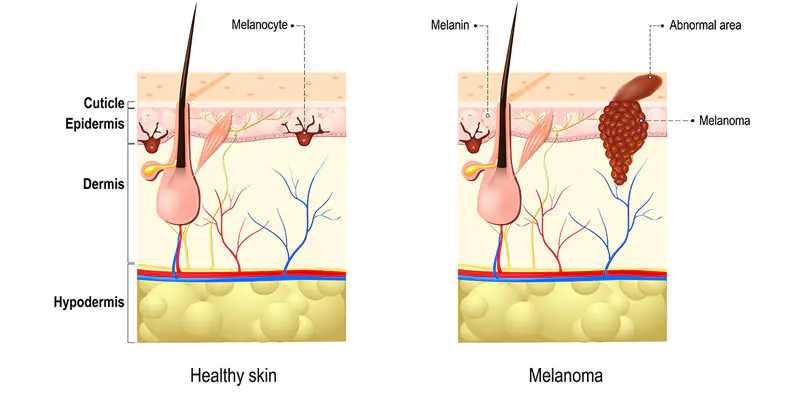
However, these so-called “floaters” can hide the most aggressive malignant tumor – melanoma. Therefore, you should know what dangerous moles are and be able to recognize the main differences between benign and malignant ones. Cancerous transformations most often occur on the basis of pigmented skin tissues.
What moles are dangerous?
Cancerous moles, like regular ones, consist of melanocytes. But this is an aggressive form of the tumor, prone to rapid spread and damage to other organs. In this regard, it is recommended to be careful with such pigmented skin formations as:
This type does not look like a regular birthmark because its size is larger than a pencil eraser, its shape is unclear, and its color is uneven. Moreover, the potential danger is posed by congenital formations, not acquired ones. Most of them are inherited and are larger than 1 cm.
Appear as a flat spot containing two or more shades of darkening. They are quite common after the age of 50 and are localized particularly on the face. Gradually they become larger and darker, transforming into skin cancer.
Neoplasms that appear suddenly develop very quickly, are aggressive in appearance and do not at all resemble an ordinary “fly”. In 60% of all cases of melanoma, this type of pigmentation functions.
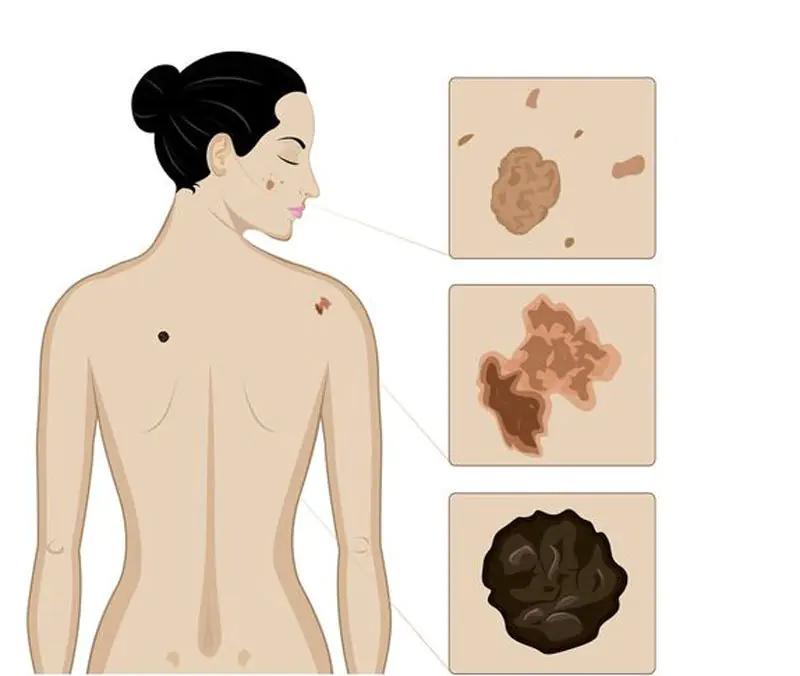
Dangerous moles: signs
A mole that has begun to change color is potentially cancerous. For example, one-color pigmentation has acquired some other spots around or in the middle.
The mole hurts, the surface becomes larger, erosions appear, the release of fluid, purulent masses or blood appears.
The skin around the formation is also distinguished by redness, swelling or the presence of new color spots, the so-called. satellite pigmentations.
There are sensations such as tingling, burning, and the mole itches.
For example, a mole softens, is divided into small pieces that break off easily, or resemble scratches that do not heal.
Which moles are potentially dangerous?
There are certain categories of birthmarks that are prone to transform into a malignant form. All of them refer to abnormal skin lumps.
1. Nodular pigmented nevi: usually brown or black moles, round and flat.
2. Skin pigmented nevi: they have a raised appearance, pale color, and sometimes a hairy surface.
3. Connecting nevi combine elements of different formations.
4. Halo nevus is a pigmented area of skin surrounded by a discolored white ring.
5. Dysplastic nevus (otherwise known as Clark) is a specific neoplasm.
6. Spitz nevus: looks like a tumor-like growth on the skin. This spot is pink (but a combination of different colors is possible), dome-shaped, prone to bleeding. May have a hole through which liquid leaks.
7. Blue nevus has one of the shades of blue, shows well-defined borders, any size (but most often does not exceed 1 cm), looks like a lump under the skin.
THE MAIN DIFFERENCES OF BENIGN MOLES FROM MALIGNANT MOLES
A number of characteristics allow you to accurately determine which moles are dangerous. The benign formation is not asymmetrical. If you draw a line through the middle, then both sides will correspond to each other.
A cancerous lump does not meet these requirements.
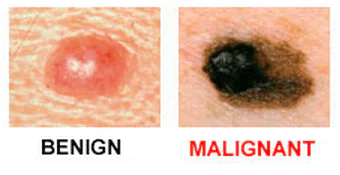
Unlike melanoma, a common pigmented spot has smooth, rather than jagged, borders.

The presence of colors and brightness is another exciting symptom.
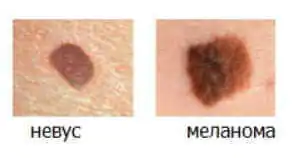
The formation changes size over time and becomes larger than 6 mm. Noncancerous nevi look the same. You need to be alert if a mole begins to grow or gives other unusual signals regarding its general condition.
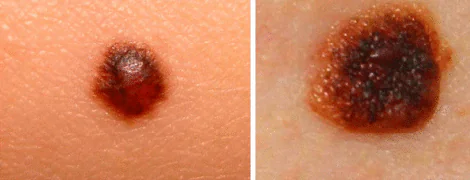
The only way to accurately establish a diagnosis and confirm or refute suspicions of cancer is to conduct a histological examination of cells using a biopsy.
Melanoma symptoms
Cancerous pigmentation can vary greatly in its symptoms. Sometimes a person is able to adequately assess only some of the features. You should pay attention to what a dangerous mole looks like. Uneven edges, but a fairly clear border with healthy tissue. Diameter – 10 mm.
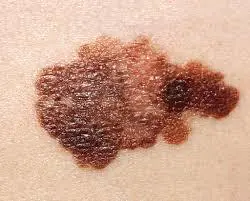
Blue-black newly formed melanoma that has irregular borders. It arose from a dysplastic nevus (pink-brown area in the upper left corner). Size about 12 mm.
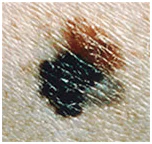
Oncological dysplastic nevus with black distant malignant extension, which was previously absent. It is only about 3 mm.
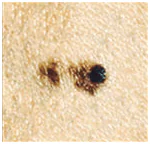
A malignant skin tumor consisting of three parts: a dark brown area on the left, a red area on the right and a light area on top. Size – about 15 mm.
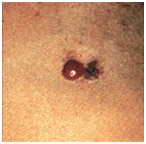
Melanoma in a dysplastic nevus: irregular contours, bright color in a relatively small size (1/3 inch).

Transformation of a single atypical pigmentation with the presence of black, brown and pink colors (1/2 inch).

Tumor formation on the lower back demonstrates asymmetry, color saturation and changes in the zone bordering healthy skin.
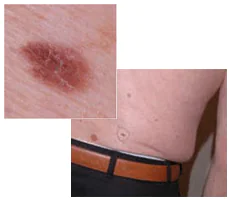
Every person should be attentive to the condition of their skin in order to diagnose dangerous moles in time and prevent possible consequences that are detrimental to health and life.
Remember that if detected early, skin cancer can be successfully treated. Published by econet.ru.
If you have any questions, ask them here
P.S. And remember, just by changing your consumption, we are changing the world together! © econet
Did you like the article? Then support us press:

In medicine, malignant moles are called melanomas. These are cancerous formations on the skin, developing from the cells of the birthmark, which form pigment. If a mole begins to bleed, changes color or accelerates its growth, then you should urgently consult a specialist. If timely, the forecasts are positive.
What is a nevus
In children, the first tiny spots may appear in infancy. A mole is a small nevus - a benign growth on the skin that is considered harmless.
They are based on melanocyte cells, which accumulate natural pigment - melanin, and its amount affects the color of moles. Education may be:

The shape of the neoplasm depends on the concentration and location of melanin, which can be distributed under the skin or be pedunculated, convex or flat. Most moles are round in shape, but there are exceptions. Their development is provoked by ultraviolet radiation (in a solarium or from the sun). A hereditary factor cannot be ruled out either. A common cause is hormonal imbalance, which is characteristic for such periods, How:
- Climax.
- Pregnancy.
- Puberty.
Types of moles
Types of nevi can be determined by several characteristics. In case of changes, this helps to correctly diagnose the disease. Neoplasms have the following differences:
- Potential threats: harmless, degenerating into melanoma, dangerous.
- in the Elevation above the dermis: birthmarks are large, pedunculated, protruding as a hemisphere, flat (even).
- Place of education: in the boundary layer, on the surface, in depth.
- Structure: vascular, pigment.
- Origin: newly acquired, congenital.
People who have dark spots on their skin need to be attentive to their changes. Timely detection of symptoms of degeneration into melanoma contributes to maintaining health and timely removal of a bad tumor. Normal moles are different:
- Lack of any changes.
- Due to the existence of the stalk, malignant cells growing randomly cannot form it.
Spots that appear on the body shortly after birth are also considered safe. The main thing is that they are small in size. Signs that the tumor is not dangerous:
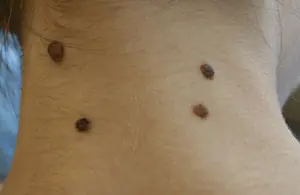
A nevus has the shape of a spot.- Symmetry.
- Diameter no more than 5 mm.
- The absence of pathology is indicated by hair that grows from the neoplasm.
- Soft consistency.
- The pattern of adjacent tissues and skin of the mole remains unchanged.
- The shade of the stain is flesh.
People who have nevi on their skin need to monitor their changes, because there is always a risk of them degenerating into a cancerous tumor. Malignant moles have the following signs:
- Uncomfortable sensations.
- The appearance of burning and itching.
- Lack of elasticity.
- Asymmetry due to uneven growth.
- Appearance of cracks.
- Rapid increase in size (more than 2 mm per year).
- The appearance of multicolor and a change in shade towards the dark side.
If you experience changes, you should immediately visit a specialist and clarify the nature of the tumors and the likelihood of developing skin cancer. The following factors can provoke pathological changes:
- Previously removed melanoma.
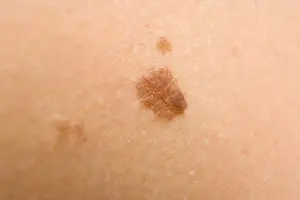
Placement in places where there is a high risk of injury: on the palms, face or hair.- Location in places where there is frequent contact with clothing: on the genitals, head or neck.
- Excessive exposure to solariums or sun.
- Self-removal.
- Injury to a mole due to negligence.
What is the danger of moles
No person is protected from the sudden proliferation of cells from harmless moles. Melanoma is a serious disease. If changes are not detected at the initial stage, then death is possible. The main provoking factor is unsuccessful removal of tumors without the help of specialists. Moles are dangerous because they can:
- With minor external changes, it actively metastasizes through the lymphatic and circulatory channels to the entire body.
- Degenerate into cancerous forms.
- Grow to large sizes.
- Transition into a precancerous (apathetic) form.
How quickly does melanoma develop?
The transformation from a mole to a cancerous tumor can occur in different ways. The process depends on the type of tumor and stage of the disease. Instant metastases are considered dangerous. Because of this it starts:
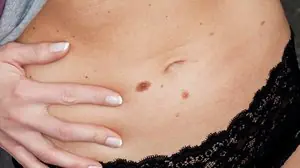
Cell growth cancer in the deep layers of the dermis.- Their entering the lymph and blood.
- Penetration into the kidneys, liver and lungs.
- Sprawl them in the listed bodies.
- Complete damage to the body.
- Fatal outcome.
Pigment cells have growth phases during which melanoma develops from a mole.
The following types are distinguished:
- Nodal. Is especially dangerous. It spreads deeply over 2 months.
- Vertical. Cancer cells spread throughout the organs. This period lasts about 2 years. The prognosis for this type is unfavorable.
- Horizontal. The upper layers of the skin are affected. Metastases do not appear. The duration of formation can reach 10 years.
Help can be provided to a person only if changes are detected in time. What needs to be done to make a person healthy is of interest to many. To begin with, it is worth conducting diagnostics and laboratory tests, and giving a referral for surgical treatment. The first symptoms of melanoma are:
- Bleeding.
- Increase in the height of the tumor.

Redness.- The appearance of discharge.
- Itching and burning.
- Softening of the nevus.
- Swelling of tissues.
- Thickening.
- The appearance of a crust.
- Pigmentation grows around the affected area.
- Hair loss.
If melanoma develops further, then signs such as:
- The appearance of pain.
- Significant change in size.
- Ulceration of the surface.
- Enlarged lymph nodes.
- Formation of new foci.
- Liquid separation.
- Bleeding from areas of pigmentation.
- Skin thickening.
- Signs of metastases: headaches, cramps, weight loss, chronic cough.
- The appearance of an earthy skin tone.
Differences between nevus and melanoma
In order to figure out whether a mole is dangerous or not, you need to know what type of formations are that can cause cancer. This can be recognized by external signs. A harmless mole looks like this:
- The diameter does not exceed 5 mm.
- The color is uniform.
- The edges are smooth.
- Symmetrical.
Dangerous melanoma looks like this:
- Parameters such as shape, size and color change.
- Diameter more than 6 mm.
- There are no clear boundaries.
- The shades are uneven, there may be inclusions.
- The asymmetry of the form is clearly expressed.
- In a short period of time, the spot grows rapidly.
Appearance of a dangerous nevus
Only a specialist can identify life-threatening neoplasms; in some cases, an ordinary person is also able to understand by appearance when he needs to seek help. This should be done in the following cases:
- Connective neoplasms that connect individual spots into a single whole.

The Spitz resembles a dome-shaped tumor with a pink tint, and there is also a hole through which fluid and blood flows.- A halo nevus is a pigment around which a white ring has formed.
- The skin is often raised and pale.
- Nodules are black or brown in color and flat or round in shape.
- Blue - subcutaneous seals with a size of no more than 10 mm and clear boundaries.
One of the symptoms of rebirth is a change in boundaries. Scalloped borders and blurred edges are very common. Dysplastic types are non-dangerous types of moles. A nevus with uneven borders is dangerous if there are additional signs of melanoma development:
- The appearance of highly indented boundaries in shape.
- Clearly expressed asymmetry.
- Fast resizing.
If such a neoplasm remains constant in size, not exceeding 5 mm in diameter, then it is not dangerous. Very often its occurrence indicates a lack of vitamins and poor nutrition. Experts recommend consulting if you find such changes:
- The diameter has increased significantly.
- Areas with different shades appeared.
- Seals and irregularities appeared in the center.
- Worrying symptoms include tingling, itching and burning.
- A smooth mole has turned into a rough one.
You need to be examined immediately if you have a rough, dangerous mole:
- The edges are blurred and irregular in shape.
- When touched, painful sensations appear.
- Purulent discharge formed.
- Asymmetry.
- The size changes rapidly.
- An inflammatory process develops.
- There was bleeding.
Pigment spots are large formations on the skin. They can be considered harmless if they do not cause inconvenience to their owner and remain unchanged. It is very common to constantly monitor their size, color and appearance. In order to eliminate worries, you should consult a dermatologist. The doctor will diagnose and predict the risk of developing a malignant mole. Large moles become dangerous in the following cases:
- Bleeding is observed.
- Changes in shape and dimensions.
- Unsuccessful self-removal.
- The itching bothers me.
- A compaction has appeared.
- Injury to formations.
What moles can be removed
Very often, moles located in prominent places (neck or face) cause a lot of trouble for women. Even if they don't bother you, you need to remove them. After the procedure, the doctor is obliged to send the tissue for histological analysis in order to find out what the nature of the formation was - malignant or benign. Surgery is not required if the tumor does not change in size, does not bother you, and is benign.
Experts say that there are no contraindications for removing moles; it is necessary to choose the right method of excision.
Moles can be removed if:
- Bleeding and inflammation appeared.
- Itching and burning.
- They greatly increase in diameter.
- There is a change in outline, shape and color.
- Localized on the head under the hair, damage may occur when cutting or combing.
- It causes pain when touched.
- The armpits, groin area and neck are injured when in contact with clothing.
You can remove moles using the following methods:
- Surgical intervention is performed in the presence of large tumors or in cases of severe growth of melanoma.
- The radio wave method is a hardware method for removing moles.
- Electrocoagulation - burning out a tumor using an electric knife.
- Cryodestruction is the removal of formation using carbonic acid or a mixture of low temperature liquid nitrogen.
- Laser therapy is carried out using a laser. Local anesthesia is used.
In any case, it is better not to hesitate if any changes in moles on the body are detected.
Every person has birthmarks of different types, textures, colors, and shapes on their body. These harmless formations arise in the epidermis from melanocytes and grow in clusters. The scientific name of a mole is nevus. This medical term applies to all skin abnormalities. However, these so-called “floaters” can hide the most aggressive malignant tumor – melanoma.
Therefore, you should know what they are dangerous moles and be able to recognize the main differences between benign and malignant. Cancerous transformations most often occur on the basis of pigmented skin tissues.
What moles are dangerous?
Cancerous moles, like regular ones, consist of melanocytes. But this is an aggressive form of the tumor, prone to rapid spread and damage to other organs. In this regard, it is recommended to be careful with such pigmented skin formations as:
From the very beginning, this type does not resemble an ordinary birthmark, since its size is larger than a pencil eraser, its shape is unclear, and its color is uneven. Moreover, the potential danger is posed by congenital formations, not acquired ones. Most of them are inherited and are larger than 1 cm.
Hutchinson's melanotic freckles (lentigo):
Appear as a flat spot containing two or more shades of darkening. They are quite common after the age of 50 and are localized particularly on the face. Gradually they become larger and darker, transforming into skin cancer.
Skin neoplasms of unknown etiology:
Neoplasms that appear suddenly develop very quickly, are aggressive in appearance and do not at all resemble an ordinary “fly”. In 60% of all cases of melanoma, this type of pigmentation functions.
Dangerous moles: signs
Color Changes:
A mole that has begun to change color is potentially cancerous. For example, one-color pigmentation has acquired some other spots around or in the middle.
Height change:
An important feature is a change in the height of the previously flat spot and density (thickening).
Painful sensations:
The mole hurts, the surface becomes larger, erosions appear, the release of fluid, purulent masses or blood appears.
Satellite pigmentations:
The skin around the formation is also distinguished by redness, swelling or the presence of new color spots, the so-called. satellite pigmentations.
Itching and burning:
There are sensations such as tingling, burning, and the mole itches.
Consistency changes:
For example, a mole softens, is divided into small pieces that break off easily, or resemble scratches that do not heal.
Which moles are potentially dangerous?
There are certain categories of birthmarks that are prone to transform into a malignant form. All of them refer to abnormal skin seals:
- Nodular pigmented nevi: Typically brown or black moles that are round and flat.
- Skin pigmented nevi: have a raised appearance, pale color, and sometimes a hairy surface.
- Connective nevi combine elements of different formations.
- A halo nevus is a pigmented area of skin surrounded by a discolored white ring.
- Dysplastic nevus (otherwise known as Clark) is a specific neoplasm.
- Spitz nevus: looks like a tumor-like growth on the skin. This spot is pink (but a combination of different colors is possible), dome-shaped, prone to bleeding. May have a hole through which liquid leaks.
- A blue nevus has one of the shades of blue, shows well-defined borders, any size (but most often does not exceed 1 cm), and looks like a lump under the skin.
The main differences between benign moles and malignant ones
A number of characteristics allow you to accurately determine which moles are dangerous:
Benign formation is not asymmetrical. If you draw a line through the middle, then both sides will correspond to each other. A cancerous lump does not meet these requirements.
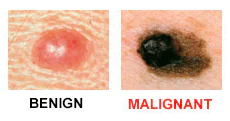
Unlike melanoma, a common pigmented spot has smooth, rather than jagged, borders.
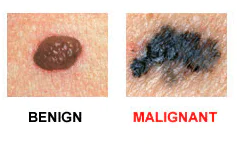
The presence of colors and brightness is another exciting symptom.
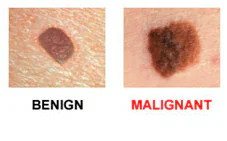
The formation changes size over time and becomes larger than 6 mm. Noncancerous nevi look the same. You need to be alert if a mole begins to grow or gives other unusual signals regarding its general condition.
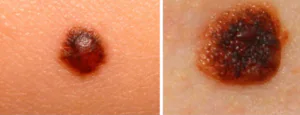
The only way to accurately establish a diagnosis and confirm or refute suspicions of cancer is to conduct a histological examination of cells using a biopsy.
Dangerous moles: symptoms of melanoma
Cancerous pigmentation can vary greatly in its symptoms. Sometimes a person is able to adequately assess only some of the features. You should pay attention to what a dangerous mole looks like:
Uneven edges, but a fairly clear border with healthy tissue. Diameter – 10 mm.

Blue-black newly formed melanoma that has irregular borders. It arose from a dysplastic nevus (pink-brown area in the upper left corner). Size about 12 mm.
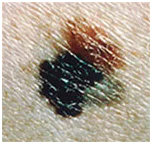
Oncological dysplastic nevus with black distant malignant extension, which was previously absent. It is only about 3 mm.
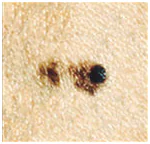
A malignant skin tumor consisting of three parts: a dark brown area on the left, a red area on the right and a light area on top. Size – about 15 mm.
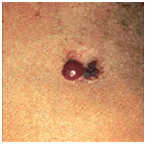
Photos of dangerous moles on the body
Melanoma in a dysplastic nevus: irregular contours, bright color in a relatively small size (1/3 inch).
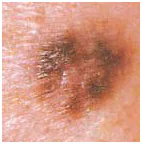
Transformation of a single atypical pigmentation with the presence of black, brown and pink colors (1/2 inch).
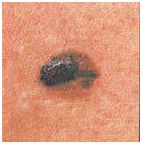
Tumor formation on the lower back demonstrates asymmetry, color saturation and changes in the zone bordering healthy skin.
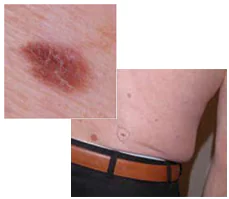
Are you unsure of the correctness of the diagnosis and treatment prescribed for you? A video consultation with a world-class specialist will help dispel your doubts. This is a real opportunity to benefit from qualified assistance from the best of the best and not overpay for anything.
Every person should be attentive to the condition of their skin in order to diagnose it in time. dangerous moles and prevent possible consequences that are detrimental to health and life. Remember that if detected early, skin cancer can be successfully treated.



